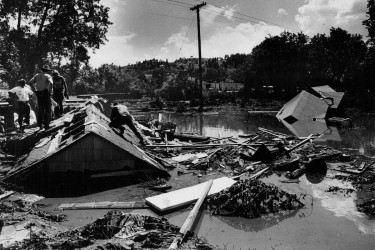Collection
American Indian Activism in the Civil Rights Era
Collective memory of Native American activism in the era of civil rights is most closely associated with the American Indian Movement (AIM), a radical grassroots civil rights organization founded in Minneapolis in 1968 that captured headlines for a standoff against the FBI at Wounded Knee in 1973. While AIM, with its militant tactics, was centrally important to the visibility of Native Americans' struggles, it was far from the only organization fighting for the cause. The resources in this collection contextualize AIM and explore the actions and legacies of a generation of American Indian activism.
Other trials, often about land ownership and sovereignty, stemmed from their legal status as recognized tribal nations. In 1956, the Seneca nation invoked the 1794 Treaty of Canandaigua to oppose the U.S. federal government on two fronts: against the Indian termination policy that tried to dissolve tribal governments, and against their displacement by the Army Corps of Engineers who sought their land to dam the Allegheny River.
Writing history can serve as a form of resistance. Native American lawyer, activist, and intellectual Vine Deloria Jr. is best known for his 1969 manifesto of Indian rights, 'Custer Died for Your Sins,' which proved consciousness-raising and inspirational for Alcatraz-Red Power and AIM activists. In 1972, he published this critique of the BIA's long history of exploitation and dereliction of its mission.
While AIM often grabbed headlines with its militant tactics, its co-founder Clyde Bellencourt focused more on the importance of the “the damn hard work” of organizing that took decades and never received media attention, but provided critical support for causes like affordable housing, youth programs, and legal aid.
From the 1890 Ghost Dance movement and Wounded Knee massacre that formed "the modern roots and spiritual center of indigenous struggle," through AIM's leadership in organizing the 1972 Trail of Broken Treaties and bringing national attention to the 1973 Wounded Knee occupation, to the 2016 natural gas pipeline protests at the Standing Rock Reservation, events in North Dakota reveal the continuities in the long history of Native American resistance.
The image of the "Crying Indian" ad, created by the Keep America Beautiful organization and the Ad Council in 1971, is potent -- and misunderstood. The "stereotype of the anti-progress traditionalist Indian opposed to all forms of industrial development" has persisted for decades, and distorts the ways in which "American Indians have been contributing to a national and international conversation about environmental health and justice since the 1960s."
Women played important leadership roles in resistance, as well, for instance, in response to a 1970 federal law promoting the sterilization of Native American women. This article details the work of chief tribal judge Marie Sanchez, who first opposed the program on the Northern Cheyenne reservation, then at the United Nations, and finally through the establishment of Women of All Red Nations (WARN).
While the 1973 occupation of Wounded Knee -- like the 1890 massacre there before it -- is often viewed as the end of the era of militant protest, it served as a catalyst for many American Indians nationwide to learn more about their heritage and to become more engaged in cultural preservation and civil rights activism.
The author makes a pilgrimage to Wounded Knee, "a reservation that routinely tops the list of the poorest places in the country, and that one study likened to a post-disaster landscape." Surveying the aftermath of a flood, he reflects on Wounded Knee's history and its meaning for the future: can such a site of genocide and resistance provide insight into survival in an age of climate crisis?
Although the Red Power movement is often defined to have ended in the mid 1970s, its ideas continue to shape Native American resistance. The author returns to the ideas of movement founders Richard Oakes and Vine Deloria Jr., and traces their legacy through subsequent grassroots organizing legal actions to protect American Indian sovereignty and civil rights.













